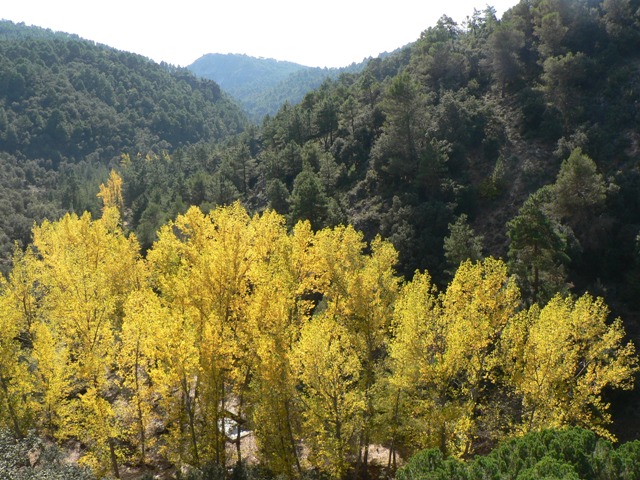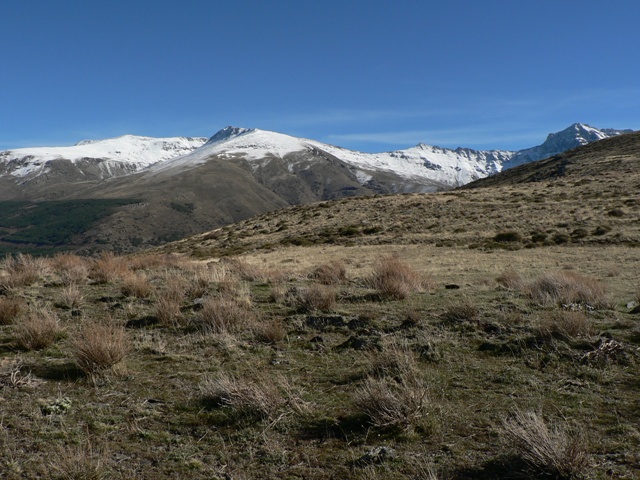Thanks to the huge altitude range, the climate of the Sierra Nevada is as varied as its scenery. One of the great benefits of this is that there is always excellent trekking to be had, whatever the season. When snow and ice make the high peaks inaccessible to all but the most experienced climbers, the foothills generally offer pleasant temperatures and spectacular views. Conversely, when the foothills are sweltering in the summer, almost anyone with a reasonable level of fitness can escape the worst of the heat by climbing Mulhacén or Veleta.
Spring
Streams gushing with crystal-clear water and meadows covered in flowers, set against a backdrop of snow-capped mountains – spring is a fantastic time to visit the Sierra Nevada. As the snow recedes, and temperatures rise, the countryside bursts into life. In the valleys, meadows soon become carpeted in red, purple, yellow and white flowers. The highest peaks are still out of reach, but this is generally the ideal time to go trekking at altitudes of up to around 2000 metres.

Remember that the amount of snow can vary greatly from year to year – sometimes there are significant amounts of snow well into July, whereas other years most of it has gone by mid-May. This will affect exactly which hikes you can do. Rivers and streams can also be very high at this time of year, making it difficult to cross them where there are no bridges.
Summer

Clear blue skies and long, hot evenings, day after day. As the snow recedes, the higher mountains start to become accessible to everyone. June is a good time to visit, before it becomes too hot. July and August, on the other hand, can be stifling, with maximum temperatures generally in the mid to high thirties centigrade. However, even in those months there is good trekking to be had; amongst other things, it is perhaps the best time of year to climb the two highest peaks in the Sierra Nevada, Mulhacén and Veleta. Even at much lower altitudes the mornings can be refreshingly cool, so if you get up early you can do a decent trek, before heading home for a siesta or to relax by the pool. If you base yourself in one of the higher villages, night-time temperatures will be more comfortable for sleeping.
Autumn
Gradually the leaves of the poplars start to take on incredibly bright shades of gold and yellow, first high up in the river valleys and eventually down in the plain, creating a stunning carpet of colour. In the many orchards, the trees are heavy with a bewildering array of fruit. This is also when the first snow falls in the high mountains and evenings get cooler.


Summer really lasts through most of September, so it is only in October that autumn really sets in, but once it does come, the change can be dramatic. As in spring, this is when daytime temperatures are best for walking at intermediate altitudes. Come prepared for rain, although with any luck you will enjoy pleasantly warm, sunny days.
Winter
When the almond trees in the Alpujarras blossom, from a distance it appears that the hills are covered in pinkish-white clouds. This amazing sight, which you can catch in February, is just one of the many things that makes winter an attractive time of year to visit the Sierra Nevada. Nights are generally cold, but when the sun is out it can feel quite warm.


Although significant snow cover is usually restricted to the higher slopes of the mountains, the odd snow shower is not uncommon in areas like the Alpujarras, Güéjar Sierra and Monachil. Although this can slightly limit your trekking options if you want to avoid the snow, the scenery is particularly beautiful at this time of year, especially on crystal-clear winter days. If it snows really heavily, you can always put your feet up in front of a roaring log fire or head up to the slopes of the ski resort.
For guide book recommendations, see our recommended reading page.
